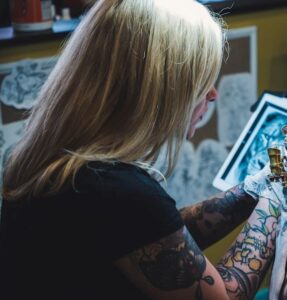The Art of Design: From Tattoos to Digital Interfaces
In the realm of visual expression, few art forms are as diverse and evolving as design. From the ancient practice of tattooing to the cutting-edge world of digital interfaces, the principles of design continue to shape our visual experiences and interactions. This article explores the fascinating parallels between tattoo artistry and digital interface design, highlighting how these seemingly disparate fields share common ground in their approach to aesthetics, user experience, and cultural impact.

The Canvas: Skin vs. Screen
At first glance, the canvas of a tattoo artist – human skin – seems worlds apart from the digital screens that interface designers work with. However, both mediums present unique challenges and opportunities that designers must navigate with skill and creativity.
Tattoo artists must contend with the contours of the body, working with (or against) muscle structure and bone to create designs that flow naturally with the human form. Similarly, digital designers grapple with varying screen sizes and resolutions, ensuring their interfaces are responsive and visually appealing across devices. Think of a social online casino for example – their slot games must be responsive in a number of devices with various screen sizes and resolutions.
Both fields require a deep understanding of their respective canvases. A tattoo artist must know how ink will settle in different skin types and how designs will age over time. Likewise, a digital designer must anticipate how their interface will function across different platforms and how it will evolve with technological advancements.
Composition and Layout
The principles of composition that guide a tattoo artist in creating a balanced, visually striking piece are remarkably similar to those employed by digital interface designers. Both must consider:
- Balance: Distributing visual elements evenly to create a sense of equilibrium.
- Contrast: Using differences in color, size, or shape to create visual interest and hierarchy.
- Emphasis: Drawing attention to key elements through size, color, or placement.
- Unity: Ensuring all elements work together cohesively.
In tattoo design, these principles might manifest in the way a large central image is balanced by smaller supporting elements, or how negative space is used to frame a design. In digital interfaces, they appear in the arrangement of buttons, the hierarchy of information, and the use of color to guide user attention.
Color Theory and Psychology
Color plays a crucial role in both tattoo and digital design. Tattoo artists must consider how different pigments will appear on various skin tones and how colors will interact within a design. They also need to account for how colors might fade or change over time.
Digital designers, while not constrained by the limitations of skin and ink, must consider how colors appear on different screens and how they affect user behavior and emotions. Both fields leverage color theory to create mood, evoke emotions, and guide the eye through a design.
The psychology of color is particularly important in digital interface design, where specific colors can signify actions (e.g., red for warnings, green for confirmations) or brand identity. Tattoo artists similarly use color to convey meaning, often drawing on cultural symbolism or personal significance to the wearer.
Storytelling and User Experience
Perhaps the most profound connection between tattoo art and digital interface design lies in their shared goal of storytelling and creating meaningful experiences.
Tattoos often carry deep personal significance, telling stories of the wearer’s life experiences, beliefs, or aspirations. The tattoo artist collaborates with the client to translate these narratives into visual form, creating a design that resonates on a deeply personal level.
Digital interface designers, too, are storytellers. They craft user journeys through applications or websites, guiding users through a narrative of interaction. Each button, animation, and layout decision contributes to the overall story of the user’s experience with the digital product.
In both cases, the designer must empathize with their audience, understanding their needs, preferences, and cultural context to create designs that are not just visually appealing but also meaningful and functional.
Adaptation and Evolution
Both tattoo artistry and digital interface design are fields that continually evolve, adapting to changing cultural trends, technological advancements, and user expectations.
Tattoo styles have transformed dramatically over the centuries, from traditional tribal designs to hyper-realistic portraits and abstract geometric patterns. Artists continually push the boundaries of what’s possible, experimenting with new techniques and styles.
Similarly, digital interface design has undergone rapid evolution since the advent of graphical user interfaces. From skeuomorphic designs that mimicked real-world objects to flat design and now to more nuanced approaches like material design, the field continues to reinvent itself.
In both realms, designers must stay abreast of current trends while also innovating and developing their unique style. This balance between tradition and innovation drives both fields forward, constantly redefining the boundaries of visual design.
Takeaways
The art of design, whether applied to the human body or a digital screen, is a powerful form of communication and expression. Tattoo artists and digital interface designers, though working in vastly different mediums, share a common language of visual principles and a commitment to creating meaningful, impactful experiences for their audiences.
As we continue to blur the lines between physical and digital realities, the insights and techniques from these two fields increasingly inform and enrich each other. The tattoo artist’s intimate understanding of personal narrative and visual symbolism can inspire more emotionally resonant digital interfaces. Conversely, the digital designer’s expertise in user flow and interaction design might influence how tattoo artists approach large-scale or interactive body art projects.
In the end, whether ink on skin or pixels on a screen, the fundamental goal remains the same: to create designs that not only catch the eye but also touch the heart, tell a story, and enhance the human experience. As these fields continue to evolve, they remind us of the enduring power of visual design to shape our world and our interactions within it.
